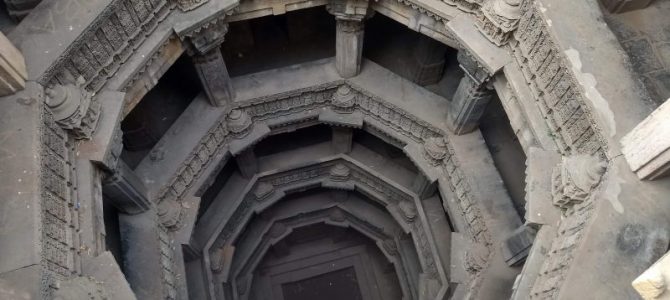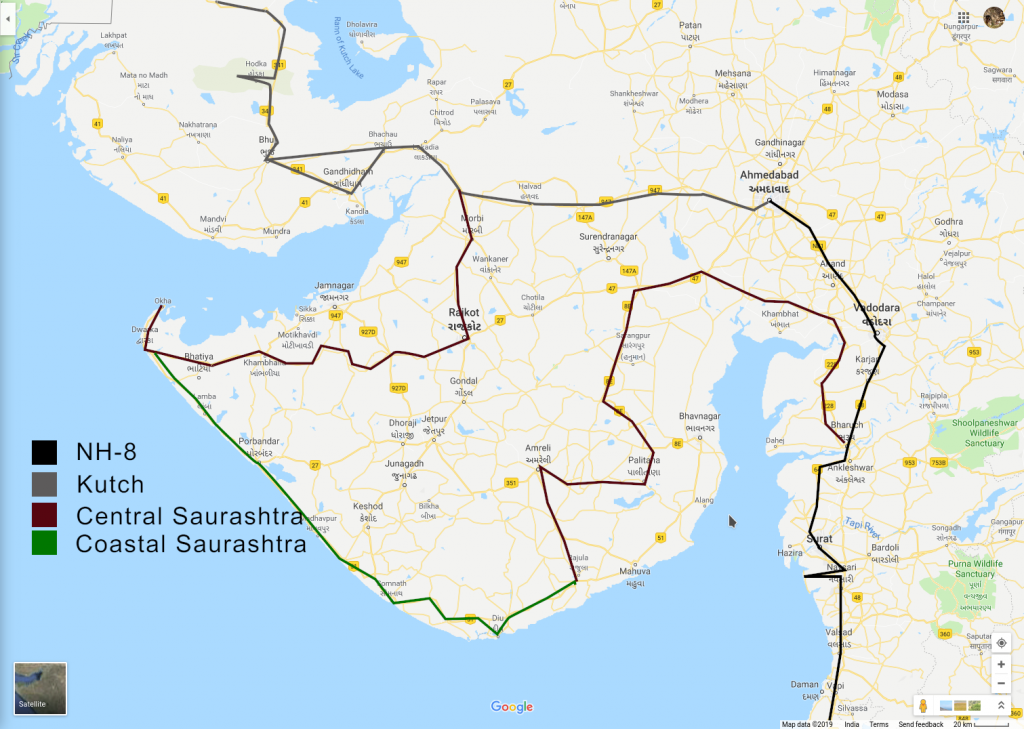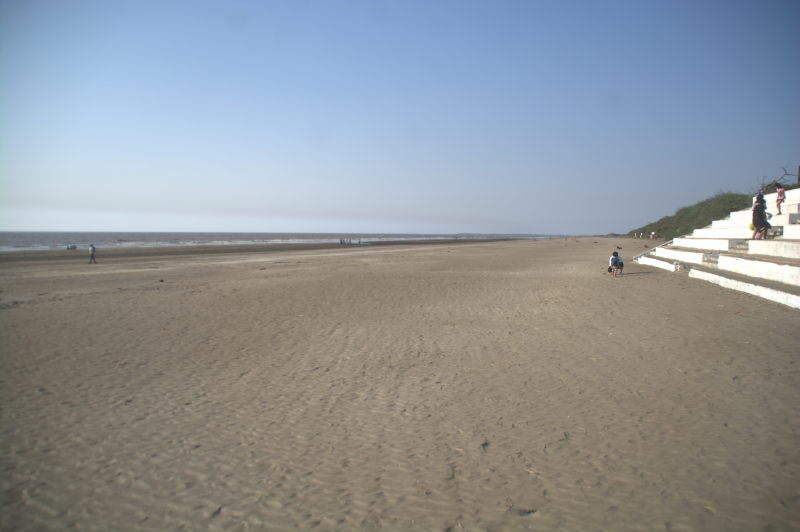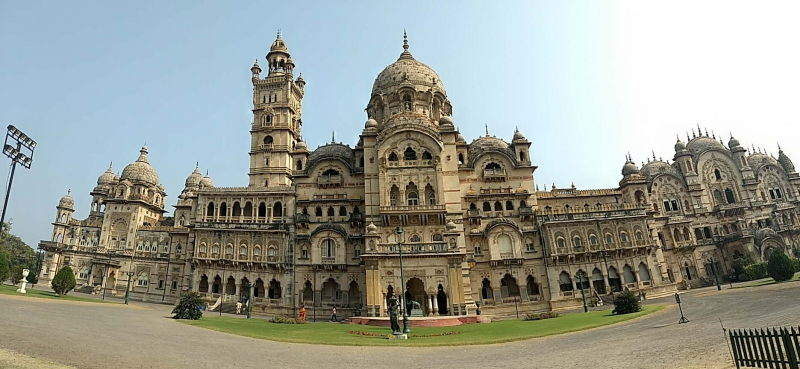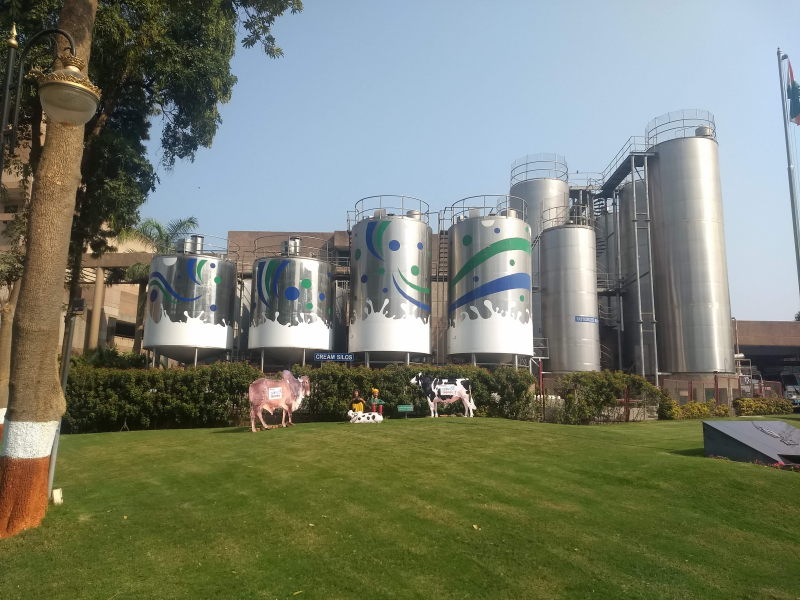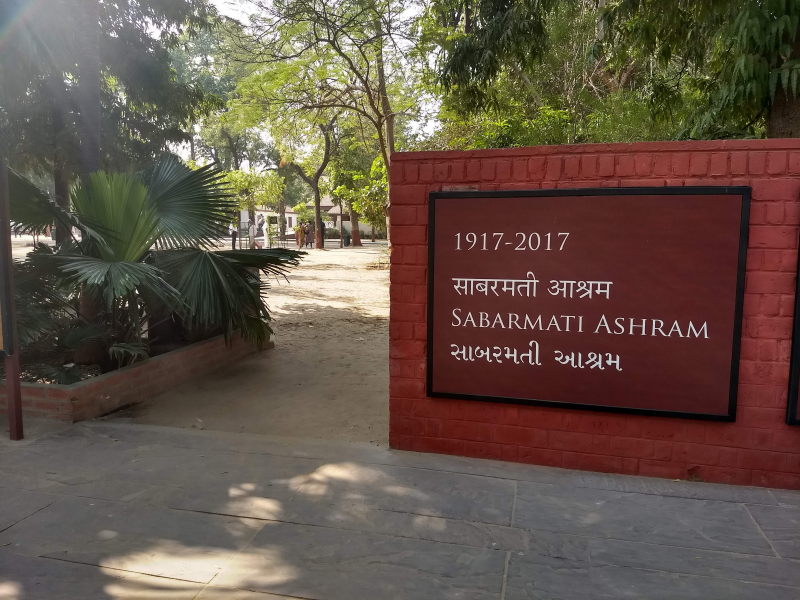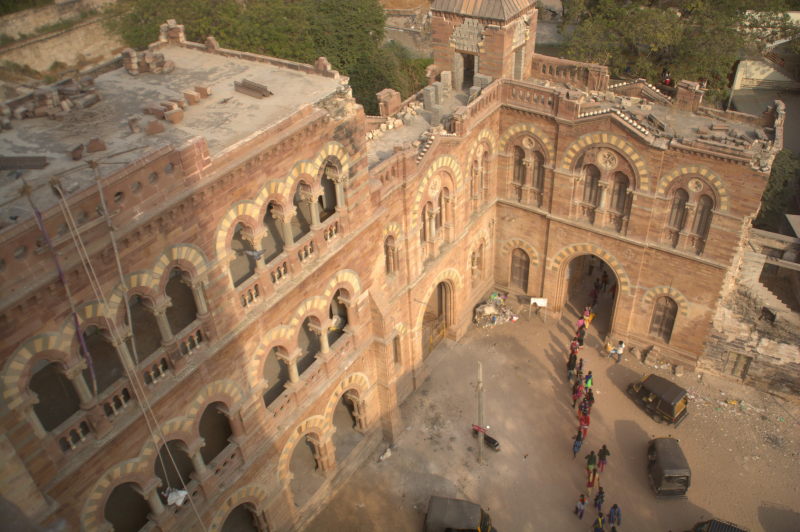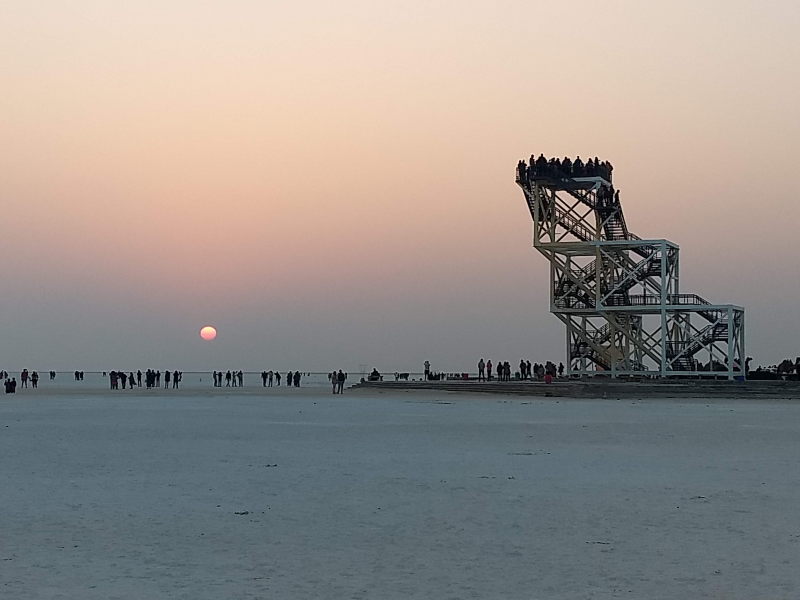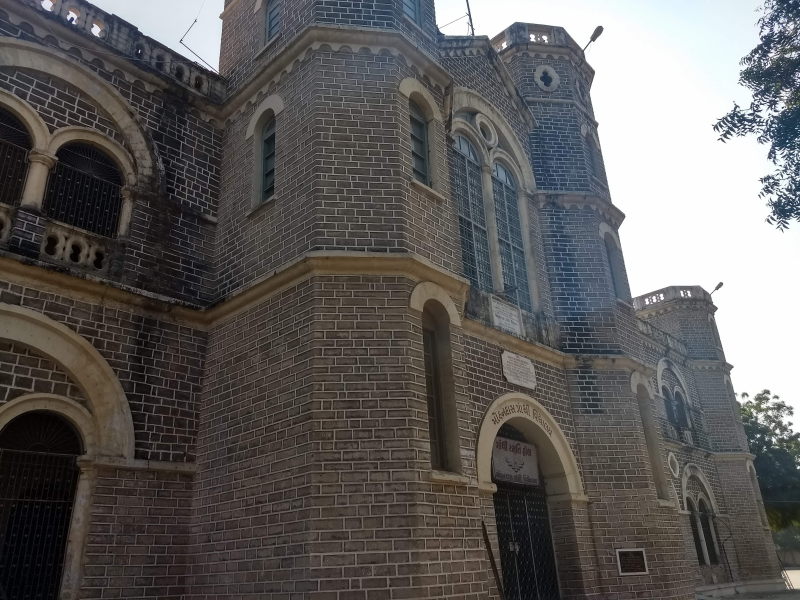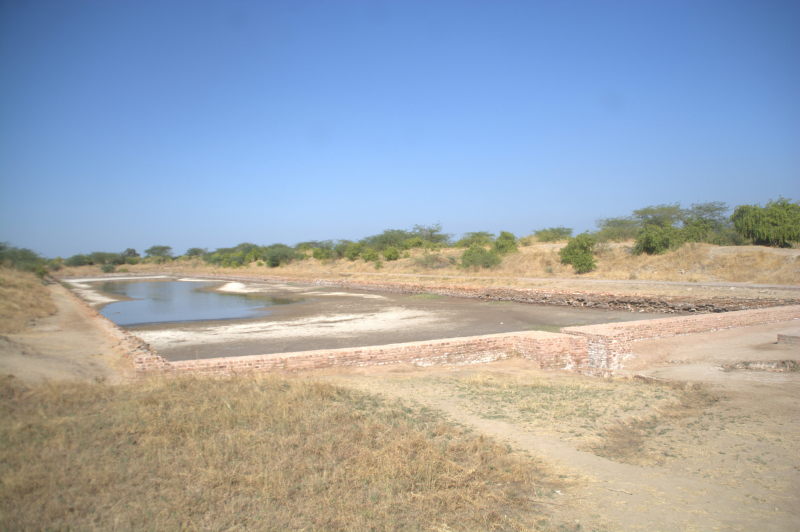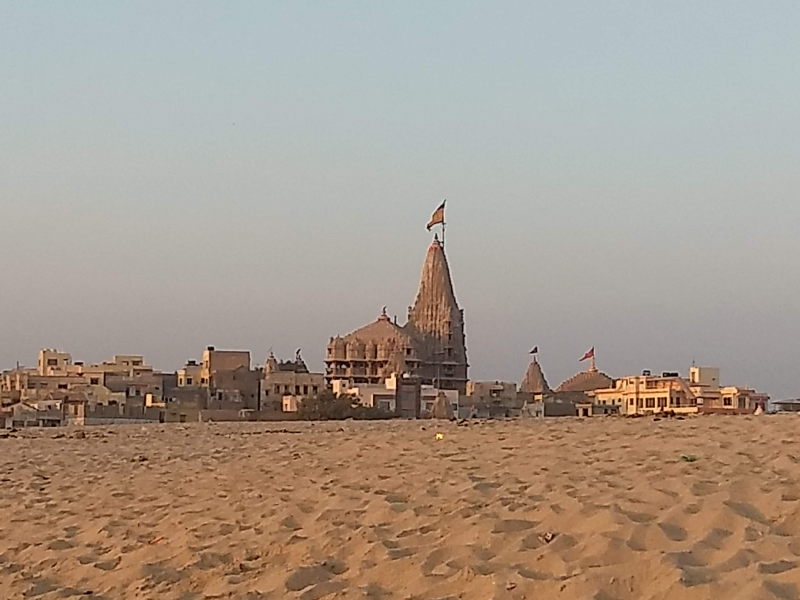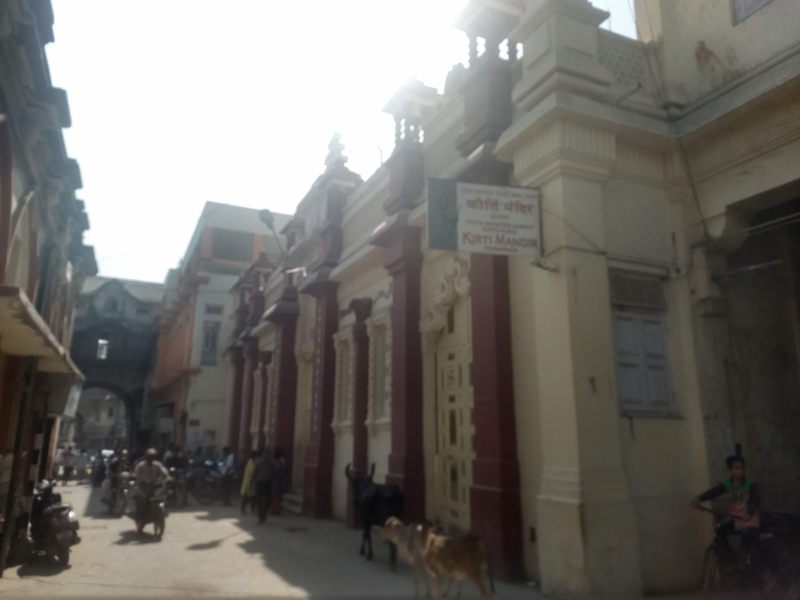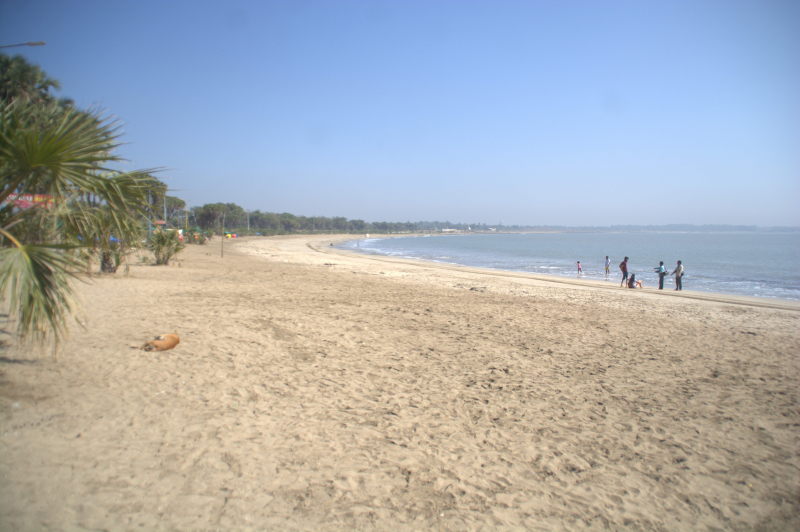Gujarat is a state that can be covered fairly quickly. In India 360, it took us 20 days to do so. While we did it by car, you can do the same circuit with a state transport bus, railways or shared taxis. A full exploration of Gujarat state, along with two union territories, Dadra & Nagar Haveli and Daman & Diu, gives you so many sights to see. From the majestic Asiatic lions to a desert of salt. From a city that cuts and polishes diamonds to a city that is home to Mahatma Gandhi. Gujarat has a variety of experiences that can amaze. So let’s get started.
Our route plan around Gujarat involved the following phases
- Cities along the national highway 8
- Kutch
- Saurashtra central
- Saurashtra coast & Diu
Here is a short summary of the four phases.
NH8: The national highway 8 is one of the two national highways that runs from Mumbai to New Delhi. NH8 runs via Gujarat, Rajasthan, Haryana and UP, using the western part of India as against the older highway NH3 that runs through central India via MP and UP. On the NH8, you will come across the most industrially, commercially and administratively developed Gujarati cities: Vapi, Valsad, Navsari, Surat, Bharuch, Vadodara and Ahmedabad. Most of the days from your Gujarat trip will be spent in these cities, since all of them have multiple places to see. Surat, Vadodara and Ahmedabad will usually require a minimum stay of 2 nights to see all their sight-worthy spots. Vapi is a place worth staying over for an lower tariff if you want to cover Daman to its west and Dadra & Nagar Haveli and Silvassa city to its east.
Kutch: From Ahmedabad, it makes sense to head towards Kutch district, where one can see Gandhidham city, Bhuj city which was the capital of the Jadeja dynasty and the white salt desert at the Rann of Kutch.
Central Saurashtra: There are a variety of places to see in Saurashtra’s central region. Rajkot is the headquarters of the region and is known for its excellent Kathiawadi food. It is also known for the school to which Gandhiji went. Other regions to see here are Lothal Harappan village, Gir lion sanctuary, Junagarh fort, Palitana Jain temple and Velavadar blackbuck sanctuary.
Coastal Saurashtra: Coastal Saurashtra is famous for two sea-side temples: Dwarka dedicated to Lord Krishna and Somnath dedicated to Lord Shiva. While touring Dwarka, one should also visit the Beyt Dwarka island from the town of Okha. Sandwiched between the two temple towns is Gandhiji’s birth town Porbandar. To the south-east of Somnath is the island of Diu, which forms one part of the Daman and Diu union territory. Finally, one can visit Bhavnagar to use the roll-on / roll-off ferry to Bharuch.
Let’s look at the places we can visit in each of the regions.
National HIghway 8
Daman: Daman is one part of the union territory of Daman and Diu. It is divided into two localities named Nani Daman (small Daman) and Moti Daman (big Daman), both of which have a beach and are connected by a road bridge. Driving around Daman, you will see plenty of Portuguese buildings that are left behind after their colonisation of Daman. They are maintained as part of the town’s heritage. While there is nothing special about Daman beach, there is a lot of hype surrounding it. This is because Gujaratis who want to consume liquor cross the state-to-territory border and are longer bound by Gujarat’s ‘dry state’ law. Once in Daman, you will be bewildered by the hype around such an ordinary city, but then realise that it is all about the permission for intoxication!
Silvassa: is the capital of Dadra and Nagar Haveli. But the city lives upto its hype and is not just a watering hole. Silvassa is built around the gigantic and beautiful Dudhni lake. It is worth spending an evening in Silvassa just to walk around the lake’s promenade.
Navsari / Dandi: Navsari is famous as the city where industrialist Jamshed Tata was born. But it is also famous as the road-head to Dandi beach, where Gandhiji broke the salt act after a 24-day walk over 384 kilometres from Ahmedabad’s Sabarmati Ashram.
Surat: Situated on the southern bank of the Tapi river, Surat is a hub for diamond cutting and polishing industry. We were lucky enough to have a contact in Surat who showed us around a state-of-the-art diamond cutting and polishing workshop. Manual labour has been replaced by computerised design and automated LASER cutting. Besides, Surat also has a thriving wholesale market for textile products.
Bharuch: is a city situated on the northern bank of the Narmada river. Bharuch is famous for its thriving market for groundnuts / peanuts. Along with Navsari and Surat, Bharuch has a sizeable population of Parsis, who have their own sumptuous cuisine like Tansak. On both sides of the Narmada river around Bharuch are Shiva temples, right at the location where the river meets the Arabian sea. Ankleshwar is on the southern bank, while Jageshwar is on the northern bank.
Vadodara: was the erstwhile capital of the what was then Baroda presidency under the British. The city was called Baroda, and is the headquarters of the Bank of Baroda. Vadodara is an important railway junction in the Western Railway. The station has existed since the 19th century when the Western Railway was named the Bombay – Baroda railway route. Vadodara is heavily influenced by the Gaekwad Maratha dynasty who continue to stay in the Lakshmi Vilas Palace. His Majesty Sayaji Gaekwad was particularly influential in the progress of the city as an industrial, educational and commercial hub.
Anand: is the town where you can find the original Amul co-operative dairy started by Padma Vibhushan Dr Varghese Kurien, the father of White revolution, an initiative that made diary industry a very sustainable, profitable and abundant industry all over India. In fact, AMUL stands for Anand Milk Union Limited. One can take a tour of the automated, high-output Amul dairy or a grass-roots training facility named Vidya dairy.
Ahmedabad: is the commercial and educational hub of Gujarat, but is not the capital as many people mistake it to be. The capital is 50 km to the north-east at Gandhinagar. Ahmedabad is known for its entrepreneurship. It has institutions like IIM and ISRO. There are several places to visit in Ahmedabad and it warrants a seperate post.
Kutch district
Gandhidham city: is the most commercially active city in Kutch region. it is known for its commercial shipping port at Kandla and also for Mandvi beach.
Bhuj: is the capital of Kutch region and was the seat of the Jadeja dynasty. The Prag Mahal, the royal palace at Bhuj, was used for the shooting of Lagaan movie. Bhuj also has other places to visit, such as Bhujia fort, Aina Mahal, Harmirsar lake and Kutch museum. The most eye-catching location at Bhuj is the traffic island with a tap that seems to be suspended in air and spewing water out of nowhere.
Rann of Kutch: This is a white desert formed of salt crystals. Studies show that this area used to be under the Arabian sea. The sea retreated and left behind a dry area covered by salt crystals, not suitable for vegetation. It is quite a moment to see the sun rise or set over the desert. Camel rides are a unique way to commute from the entrance of the Rann to a tower viewpoint from where the vast expanse of the desert can be seen.
Dholavira: is a piece of land inside the Rann of Kutch lake, connected to the rest of India by a narrow land passage. But for that passage, Dholavira would be an island. It is famous for relics from an ancient settlement dating back to the times of Mohenjo Daro and Harappa (5000 years ago).
Central Saurashtra
Rajkot: Rajkot is the principal city of Saurashtra region. The people inhabiting this city are named Kathiawars. Rajkot was where Gandhiji attended school as a child. The school still exists and can be seen as a British-styled stone building. Rajkot is also the place to eat authentic Kathiawari cuisine.
Gir forest: Gir is a sanctuary where you can see Asiatic lions. In fact this is the only forest in India with these lions. The Gir forest takes up a sizeable chunk of central Saurashtra and spans two districts: Junagarh, and Amreli.
Palitana: is a pilgrimage town and is the most holy place for Jains. The town is at the foot of Shatrunjaya hill, on top of which is a complex of Jain temples, the chief of them being the Adinath temple. Palitana is a 100% vegetarian city and even the possession of non-vegetarian food is outlawed. So be careful not to carry any such food items when you are here. Even a bottle of egg-based mayonnaise somewhere in your rucksack (if subject to checking) can potentially get you a reprimand!
Velavadar: Velavadar is the second sanctuary in central Saurashtra alongside Gir. But the prized animal here is the blackbuck. You can see them even while driving at the border of the forest.
Lothal: is a village with relics from the times of Harappans. Lothal was clearly a port city with a ship dock and a canal connecting the dock to the sea. Records at the Lothal museum show that the Lothal Harappans had thriving sea routes and trade relations with the Sumerians and Babylonians (both ancient Iraq).
Coastal Saurashtra
Dwarka – Okha: are towns believed to be in the area where Lord Krishna was born. The Dwarkadheesh temple is the chief temple situated on Dwarka beach. At Okha, one can catch a ferry to the island of Beyt Dwarka, which also has another Dwarkadheesh Krishna temple. The Dwarka – Okha area is famous for its specially made handloom called Okhai.
Porbandar: is the birthplace of Mahatma Gandhi. His ancestral house has been converted into a museum and a temple named the Kirti Mandir.
Somnath: Situated near the city of Veraval, Somnath temple is a Shiva temple and is one of the 12 Jyotirlingas.
Diu: is an island that constitutes one part of the union territory of Daman and Diu. Diu was a Portuguese port in western India alongside Panaji in Goa, Vasai in Maharashtra and Kozhikode in Kerala. To protect the port, the Portuguese built the multi-storeyed and militarily capable Diu fort, which is a heritage structure today. There are three laidback beaches in Diu island. Finally, a natural rock structure with interconnected caves called Naida caves are a natural wonder in Diu.
Conclusion
Gujarat is a colourful state with a lot to offer. After all it has produced powerful leaders like Mahatma Gandhi, Sardar Vallabhbhai Patel, Jamshed Tata, Morarji Desai and Narendra Modi. So it makes sense to dive deep and learn more about the culture of such a state. From a white desert to a beach temple, from small handicrafts to diamond cutting and polishing, Gujarat has so much to see.

